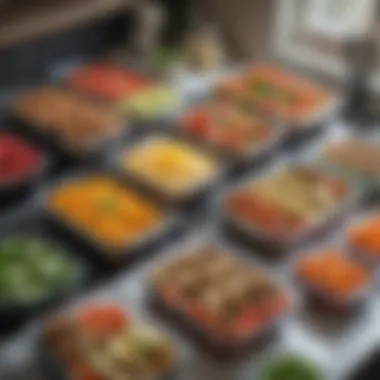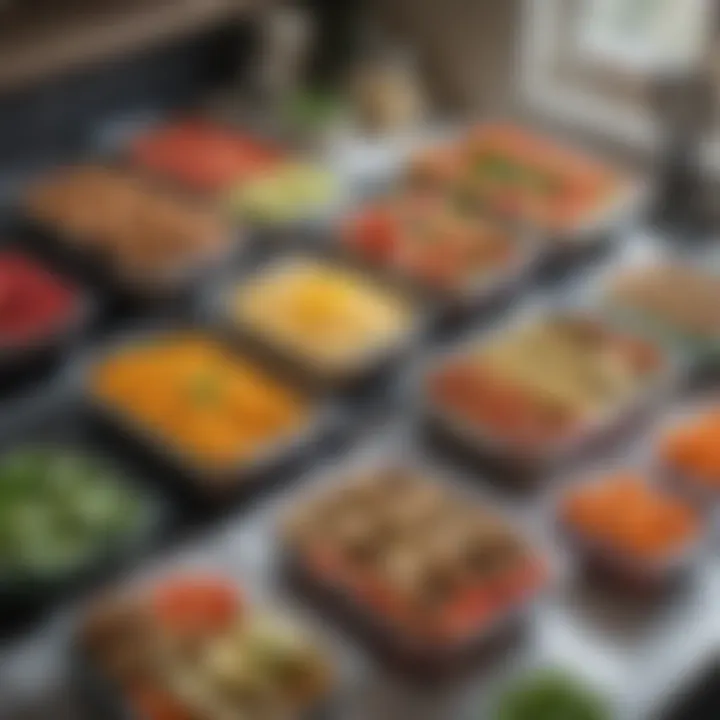Vegetarian Meal Planning for Effective Weight Loss


Intro
Vegetarian meal planning has gained traction in recent years, particularly among those looking to lose weight in a healthy way. Many people undervalue the impact of what they eat on their weight loss journey. This article aims to deliver comprehensive guidance on how to effectively plan vegetarian meals that promote weight loss. Proper meal planning enables individuals to make conscious food choices, ensuring they meet their nutritional needs while enjoying delicious flavors.
Understanding the balance between nutrient intake and caloric expenditure is critical. Vegetarians often face the challenge of ensuring adequate protein intake and avoiding empty calories. Thus, selecting the right ingredients is essential. This article will guide you through grocery shopping, meal prep, and recipe ideas that prioritize health.
Moreover, this guide covers essential tools and techniques for busy individuals. These tools will help simplify cooking, allowing you to focus on balanced meals. You will also find insights into portion control and mindful eating to support sustainable weight loss.
Adopting a vegetarian lifestyle does not mean you have to sacrifice taste or satisfaction. In fact, with a thoughtful approach, you can enjoy a variety of flavorful dishes. This resource aims to empower you with practical strategies and insight into making vegetarian meal planning an integral part of your weight loss efforts.
Understanding Vegetarian Meal Planning
Understanding vegetarian meal planning is a crucial component for individuals aiming to lose weight while adhering to a plant-based diet. This section delves into various aspects of vegetarianism, including what it means to be vegetarian, the health advantages associated with such diets, and common misconceptions surrounding them. By comprehending these fundamental elements, individuals can lay the groundwork for effective meal planning that is both nutritious and satisfying.
Defining Vegetarianism
Vegetarianism is a dietary choice characterized by the exclusion of meat, poultry, and fish. This often includes a wide variety of plant-based foods such as fruits, vegetables, legumes, nuts, seeds, and whole grains. Different types of vegetarian diets exist, including lacto-vegetarian, ovo-vegetarian, and lacto-ovo vegetarian, which allow for dairy or eggs, respectively. Each approach offers its own benefits.
Understanding these definitions is essential. It helps individuals identify which type of vegetarianism aligns with their health goals and ethical beliefs. Moreover, it serves as a guide for effective meal planning that meets nutritional needs while aiding in weight loss.
Health Benefits of a Vegetarian Diet
A vegetarian diet is linked to numerous health advantages that support weight loss and overall well-being. Here are some key benefits:
- Reduced Caloric Intake: Vegetarian diets tend to be lower in calories than diets high in meat and animal products.
- Improved Nutrient Density: Plant-based foods are rich in essential nutrients, vitamins, and minerals.
- Heart Health: Many studies suggest that vegetarians have a lower risk of heart disease, attributed to higher intake of fiber and lower intake of saturated fats.
- Weight Management: A well-balanced vegetarian diet can promote healthy weight loss due to its high fiber content, which enhances satiety.
- Reduced Risk of Chronic Diseases: Consuming a variety of fruits and vegetables has been linked to a lower incidence of diseases such as type 2 diabetes and certain cancers.
"A diverse vegetarian diet can engender significant health benefits while promoting weight loss, making it a wise choice for many individuals."
Common Misconceptions
Despite growing awareness about vegetarianism, several misconceptions still persist. Addressing these myths is vital in promoting informed dietary choices. Some common misconceptions include:
- Lack of Protein: Many believe that avoiding meat leads to protein deficiency. However, numerous plant-based sources like lentils, beans, and quinoa provide ample protein.
- Limited Food Choices: Some think vegetarianism limits meal options. In reality, vegetarian diets encompass a vast array of foods that can be creatively combined.
- Not Suitable for Everyone: Some argue that vegetarian diets are not suitable for children or those with health issues. However, with careful planning, a vegetarian diet can be well-balanced for all age groups.
Understanding these misconceptions can empower individuals to embrace vegetarian meal planning confidently. It also enables one to navigate challenges while reaping the health benefits of a plant-based lifestyle.
Nutritional Considerations for Weight Loss
Understanding nutritional considerations is crucial in the quest for weight loss, especially within the context of a vegetarian diet. Nutrition influences one’s overall health and well-being. By focusing on what to eat, individuals can make better choices that support their weight loss goals. When meals are planned with the right nutritional balance, the body receives the necessary fuel to operate efficiently, which is essential for burning calories and losing weight.
Macronutrient Balance
Proteins
Proteins serve as the building blocks of the body. In vegetarian meal planning, proteins are important because they help in muscle growth and repair. They increase the feeling of fullness, which can reduce overall calorie intake. High-protein vegetarian options include lentils, chickpeas, and quinoa. Incorporating these foods can be beneficial for anyone pursuing weight loss. The unique characteristic of plant-based proteins is that they often come with additional nutrients, enhancing their overall value. However, some plant proteins may require combining to achieve a complete amino acid profile.
Carbohydrates
Carbohydrates provide the primary source of energy for the body. They are essential for anyone planning their meals to lose weight. The key characteristic of carbohydrates in a vegetarian diet is that they can come from whole foods like fruits, vegetables, and whole grains. These types lead to slower digestion and sustained energy. Complex carbohydrates also help keep one satisfied for longer periods. The unique feature of these carbohydrates is their fiber content, which supports digestive health. However, not all carbs are created equal. Refined or simple carbohydrates can lead to spikes in blood sugar and should be limited.
Fats
Fats play a vital role in hormone regulation and nutrient absorption. In a vegetarian diet, healthy fats from sources like avocados, nuts, and seeds can support weight loss when consumed in moderation. The beneficial aspect of fats is that they enhance satiety, helping to manage hunger levels. Different fats, like omega-3 and omega-6 fatty acids, have various health benefits. However, it's also worth noting that fats are calorie-dense, meaning that portion control is necessary to avoid exceeding calorie needs.
Micronutrient Importance
Vitamins
Vitamins are essential for various bodily functions. They help in processes like boosting immunity, promoting energy metabolism, and supporting overall health. In a vegetarian meal plan, vitamins from fruits and vegetables are abundant. The key aspect of vitamins is that they contribute to well-being while being low in calories. This makes them a smart choice for weight loss. However, some vitamins, like B12, may need to be supplemented for those not eating animal products.
Minerals
Minerals are crucial for body functions such as fluid balance, bone health, and muscle contractions. For those on a vegetarian diet, incorporating a variety of whole foods ensures adequate mineral intake. The key characteristic of minerals is their role in metabolic processes. This supports the overall aim of weight loss. However, some common minerals, including iron and calcium, might require special attention in vegetarian meal planning. Ensuring rich sources from legumes, nuts, and fortified foods helps maintain balance.
Fiber's Role in Weight Management
Fiber is known for its ability to promote digestive health and enhance satiety. Eating high-fiber foods can help manage hunger levels effectively, which is crucial for weight loss. Vegetarians typically consume a wealth of fiber-rich foods, which contributes to feeling full longer. The impact of fiber on weight management stems from its slow digestion and ability to regulate blood sugar levels. Furthermore, a high-fiber diet can also lead to improved gut health, an often overlooked but vital aspect of weight management. Incorporating beans, whole grains, and fruits into meals can significantly support a successful weight-loss strategy.
Essential Ingredients for a Vegetarian Diet
Selecting ingredients for a vegetarian diet is fundamental for anyone looking to lose weight effectively. Essential ingredients not only provide the necessary nutrients for health but also contribute to satiety, making it easier to maintain a caloric deficit. Understanding what these ingredients are and how to incorporate them into meals will greatly enhance the weight loss journey.
Legumes and Pulses
Legumes and pulses, like lentils, chickpeas, and black beans, serve multiple roles in vegetarian meal planning. They are rich in protein and fiber, both of which can help in weight loss by promoting fullness. These foods are versatile; they can be added to salads, soups, or blended into spreads. One cup of cooked lentils contains about 18 grams of protein, making them a substantial option for anyone needing to meet protein goals on a vegetarian diet.
They are also economical. Buying dried beans can save money compared to pre-packaged protein sources. The added benefit is the range of vitamins and minerals they deliver, including iron and folate. This nutrient density is particularly important for those avoiding animal products, as it helps in preventing deficiencies. In summary, legumes and pulses are foundational in vegetarian meal planning due to their nutritional profile and versatility.
Whole Grains
Whole grains like quinoa, brown rice, and oats provide carbohydrates necessary for energy, especially important for active individuals. Unlike refined grains, whole grains retain the bran and germ, ensuring they deliver more fiber and essential nutrients. This fiber enhances digestion and aids in feeling full longer, thus helping control overall calorie intake.
Moreover, whole grains are known to stabilize blood sugar levels, preventing spikes that can lead to cravings or overeating. Opting for whole grains instead of their refined counterparts fosters a sense of satisfaction, making it easier to stick to a meal plan. Incorporating a variety of whole grains in meals can also prevent dietary monotony, ensuring balanced intake of essential nutrients.
Fruits and Vegetables


Fruits and vegetables are crucial components for a successful vegetarian diet. They are low in calories but high in volume, providing essential vitamins, minerals, and antioxidants that support overall health. The colorful variety available offers numerous options that not only enhance the visual appeal of meals but also deliver different health benefits.
The fiber content in fruits and vegetables promotes healthy digestion and contributes to satiety, making them excellent for weight loss. For example, apples and carrots are high in water and fiber, helping one feel full without adding excessive calories. Integrating a wide array of these foods can also reduce the likelihood of nutrient deficiencies while maximizing the variety of flavors in meals.
Healthy Fats
Despite misconceptions about fats in a diet, healthy fats derived from sources like avocados, nuts, and olive oil play an essential role in a vegetarian meal plan. Fats are important for nutrient absorption, particularly for fat-soluble vitamins A, D, E, and K. They also promote satiety, stabilizing energy levels and supporting weight loss.
Including healthy fats in meals can prevent cravings and help maintain a balanced diet. For instance, sprinkling a handful of walnuts on a salad can provide both flavor and texture, in addition to valuable omega-3 fatty acids. Being mindful of portion sizes is key, as fats are calorie-dense, but incorporating them in moderation contributes to overall health.
"Integrating essential ingredients into your vegetarian meals supports both nutritional needs and weight loss goals."
Meal Planning Framework
Setting Goals
The first step in establishing a meal planning framework involves setting specific, measurable, attainable, relevant, and time-bound (SMART) goals. These goals should reflect the individual's personal motivations, such as losing a specific number of pounds or adopting healthier eating habits. Goals can provide a clear direction and a motivational boost throughout the journey.
- Specificity is important. Instead of saying "I want to lose weight," a more defined goal would be "I want to lose 10 pounds in 3 months."
- Measurable goals are trackable. Keeping records of weight changes can illustrate progress.
Additionally, it can be effective to break down larger goals into smaller, manageable steps, like focusing on meal prep for one week at a time. This approach not only makes goals attainable but also builds momentum and confidence.
Creating a Weekly Menu
Building a weekly menu is the practical implementation of the meal planning framework. This menu provides a snapshot of what meals and snacks will be prepared and eaten throughout the week. Having a structured menu helps streamline grocery shopping and saves time during busy weekdays.
A well-planned weekly menu typically includes:
- Balanced Meals: Each day should contain a variety of food groups. For instance, plan for meals that incorporate legumes, whole grains, fruits, and vegetables.
- Diverse Choices: Include different recipes each week to avoid monotony and keep meals exciting. Trying new ingredients and flavors can be engaging and rewarding.
- Flexibility: Be open to adjustments. Life is unpredictable. If a meal doesn’t happen as planned, having a flexible attitude can enhance the overall experience.
- Time Management: Allocate specific days for cooking more complex meals and set aside quick-prep days for simple, nutritious options.
A structured approach to meal planning order encourages healthier choices, which leads to more satisfying meals.
In addition, consider incorporating seasonal produce into the menu to enhance flavor and nutritional profiles while supporting local agriculture. Regularly updating menus can keep the dietary plan fresh and aligned with changing nutritional needs.
Implementing this meal planning framework ensures that vegetarian meals are not only useful for weight loss but also enjoyable. This strategic approach empowers individuals to take control over their diets and make informed choices.
Grocery Shopping for a Vegetarian Diet
Making a Shopping List
Before heading to the store, making a shopping list is essential. A well-structured list helps avoid impulse buying and ensures the purchase of nutritious foods. Here are some tips for creating an effective shopping list:
- Plan meals in advance: Outline what meals to prepare for the week. This approach gives direction during shopping and promotes a balanced diet.
- Include staples: Essential items like legumes, grains, and fresh produce should be on your list, as they form the foundation of a healthy vegetarian diet.
- Be flexible: While having a list is important, being open to seasonal produce can lead to discovering new ingredients. Seasonal fruits and vegetables are often fresher and can enhance meal variety.
Navigating the Store
When it comes to navigating the store effectively, being mindful of what is available is crucial. Different sections often carry varied health benefits.
Fresh Produce
Fresh produce represents the backbone of any vegetarian diet. The high water content and rich nutrients found in fruits and vegetables are paramount for overall health. Eating a diverse range of produce is linked to improved digestion and energy levels. Fresh fruits and vegetables provide essential vitamins, minerals, and antioxidants, which help in weight management.
However, fresh produce does have its drawbacks. It can spoil quickly if not consumed in time, leading to food waste. To mitigate this, consider selecting items that have varying shelf lives.
Canned Goods
Canned goods can be a convenient option for busy schedules. They often have a long shelf life and can be just as nutritious as their fresh counterparts. In fact, canned legumes, such as beans and chickpeas, are quick sources of plant-based proteins. This option allows for easy incorporation into meals, making meal prep simpler.
Nevertheless, it’s important to check the labels. Some canned products contain added sugars or high sodium levels, which may not align with weight loss goals. Choosing low-sodium varieties ensures that the health benefits are maximized without unwelcome extras.
Frozen Options
Frozen options represent another smart choice for meal planning. Freezing preserves the nutrients in fruits and vegetables, capturing peak freshness. These products can be easily stored for long periods, reducing shopping frequency. Frozen vegetables can also be a quick addition to meals, saving time spent on chopping and prepping.
That said, not all frozen products are created equal. Some may contain sauces or preservatives that can add unwanted calories. Always read the ingredients before making a selection.
While navigating the grocery store, prioritize fresh produce, choose carefully among canned goods, and embrace the convenience of frozen options. This strategy supports your vegetarian meal planning while contributing to weight management.
Meal Prep Techniques
Meal prep techniques play a crucial role in vegetarian meal planning for individuals focusing on weight loss. These methods not only help in organizing the cooking process but also ensure that healthier choices are readily available. Preparing meals in advance can significantly reduce the temptation for unhealthy options when hunger strikes. By investing some time into meal prep, one can streamline their diet while maintaining variety in their meals. Here, we will discuss two essential aspects: batch cooking basics and storage solutions.
Batch Cooking Basics
Batch cooking involves preparing large quantities of food at once. This approach allows for efficiency and convenience throughout the week. Many people find it challenging to cook daily, but with batch cooking, one can allocate a few hours once a week to create several meals. This saves time, which can be crucial for busy individuals.
When batch cooking, consider the following:
- Choose versatile recipes: Dishes that can be used for multiple meals can minimize repetition. Options like veggie stir-fries or hearty soups work well.
- Focus on core ingredients: Ingredients that can be easily portioned and re-used in various recipes enhance meal diversity. For example, quinoa, beans, and various vegetables can star in different meals.
- Plan for variety: Storing different combinations of ingredients allows for creative meals throughout the week. Prepare enough base ingredients and mix them differently to avoid monotony.
By mastering batch cooking, individuals set the stage for healthier eating habits, ensuring access to nutritious meals to support weight loss goals.
Storage Solutions
Proper storage is critical for maintaining the quality and safety of prepared meals. This section covers containers and freezing options, which are key areas of focus.
Containers


Containers serve as essential tools for storing prepared meals, contributing greatly to the effectiveness of meal prepping. A key characteristic of quality containers is their airtight seal, which prevents spoilage and maintains freshness.
When choosing containers, consider these factors:
- Material: Glass containers tend to be more durable and can withstand temperature changes from cooking and reheating. Plastic options, while lighter, may degrade over time.
- Size variety: Having containers in various sizes can help manage different portion sizes effectively, whether for snacks, lunches, or dinners.
Unique feature: The design of stackable containers can save space in a refrigerator, making organization easier. However, some may find that plastic containers can retain odors or stains from certain foods, which is a minor disadvantage.
Freezing Options
Utilizing freezing options can extend the shelf life of vegetarian meals, allowing for easy access to food on busier days. One key characteristic of freezing is its ability to preserve the nutritional value of meals while locking in freshness.
Consider the following when freezing meals:
- Labeling: Clearly label containers with the contents and the date frozen. This practice prevents confusion and ensures foods are consumed within a reasonable time frame.
- Portion control: Freezing meals in single servings helps maintain portion sizes, making it easier to manage caloric intake during weight loss efforts.
Unique feature: Freezing can be particularly useful for cooked legumes, grains, or stews that can be quickly reheated. However, some individuals may find that freezing alters the texture of certain vegetables, which may not be favorable in every dish.
Recipe Ideas for Weight Loss
Recipe ideas for weight loss are a fundamental aspect of vegetarian meal planning. They not only offer variety and flavor, but they also help in maintaining a balanced diet while focusing on reducing caloric intake. Each meal should emphasize nutrient density, which means choosing foods that are high in vitamins and minerals but low in calories. This is crucial for sustaining energy levels and overall health during weight loss. Additionally, creatively prepared vegetarian dishes can keep boredom at bay, making it easier to adhere to healthier eating habits.
Breakfast Options
Breakfast is often termed the most important meal of the day. When planning a vegetarian breakfast for weight loss, consider options that are rich in protein and fiber, which can keep you full longer. Some effective breakfast ideas include:
- Overnight oats: Combine rolled oats with almond milk, chia seeds, and your favorite fruits like berries or bananas. This dish is nutritious and can be prepped in advance.
- Smoothie bowls: Blend spinach, banana, and a scoop of plant-based protein powder. Top it with nuts, seeds, or granola for crunch and additional nutrients.
- Veggie omelette: Whip up an omelette using egg substitutes or egg whites. Add spinach, bell peppers, and onions for flavor and vitamins.
These breakfast options are not only easy to prepare but also provide a healthy start to your day.
Lunch Ideas
For lunch, it is vital to balance flavors and textures to maintain satisfaction throughout the afternoon. Here are a few vegetarian lunch ideas:
- Quinoa salad: Mix cooked quinoa with chickpeas, diced cucumber, cherry tomatoes, and a lemon vinaigrette. This salad is full of protein and fiber.
- Vegetable stir-fry: Use a variety of vegetables like broccoli, bell peppers, and carrots, stir-fried in light soy sauce or teriyaki sauce. Serve over brown rice or whole grain noodles.
- Lentil soup: Cook lentils with vegetable broth, carrots, celery, and spices. This hearty soup can be made in larger batches for multiple meals.
These meals provide essential nutrients and help manage your hunger.
Dinner Recipes
Dinner often tends to be the largest meal of the day. However, it can still be healthy and conducive to weight loss. Consider these dinner recipes:
- Stuffed bell peppers: Fill bell peppers with a mixture of brown rice, black beans, corn, and spices, then bake until tender.
- Zucchini noodles: Create a pasta-like dish with spiralized zucchini, tossed with marinara sauce and your choice of vegetables.
- Chickpea curry: Cook chickpeas in coconut milk with curry spices. Serve it with a small portion of brown rice.
Aiming for nutrient-dense meals in the evening can help with digestion and prevent late-night snacking.
Snack Suggestions
Snacking is an essential part of meal planning, especially during weight loss. Healthy snacks can stave off hunger and prevent overeating during meals. Some practical snack ideas include:
- Hummus and veggies: Pair carrot sticks or cucumber slices with hummus for a satisfying crunch and protein boost.
- Greek yogurt: Opt for plain Greek yogurt topped with a drizzle of honey and fresh fruit. This offers probiotics and keeps hunger at bay.
- Roasted chickpeas: Season canned chickpeas with your preferred spices and roast until crispy. They provide protein and fiber.
Incorporating these snacks into your daily meal plan can sustain energy levels while promoting weight loss.
Good recipe ideas for weight loss not only satisfy hunger but also contribute to the overall enjoyment of a vegetarian diet. Keeping meals varied is key to long-term success.
Portion Control and Serving Sizes
Portion control and serving sizes play a critical role in the success of any weight loss endeavor, particularly within the realm of vegetarian meal planning. Understanding how much to eat and the implications of serving sizes can directly influence caloric intake and overall health. When transitioning to or maintaining a vegetarian diet, being mindful of portion sizes is essential to ensure nutrient density without excess. This approach not only supports weight loss but also promotes a balanced consumption of vitamins, minerals, and other essential nutrients.
Understanding Serving Sizes
Serving sizes refer to the quantity of food designated for a single meal or snack. Familiarity with appropriate serving sizes is crucial for several reasons:
- Caloric Awareness: Knowing how much to eat helps in tracking caloric intake. For instance, a serving of whole grains like quinoa or brown rice typically falls around half a cup when cooked. Without attention to this detail, it’s easy to consume more calories than intended.
- Nutritional Balance: Each serving is designed to provide a specific amount of nutrients. For example, serving sizes of legumes such as lentils or chickpeas are typically a half cup, which supplies both proteins and fiber.
- Avoiding Overeating: Understanding what a serving size looks like helps in preventing overeating. Many people consume larger portions simply due to habit rather than hunger.
It's advisable to refer to established guidelines such as those from the United States Department of Agriculture (USDA) to hone in on appropriate serving sizes for various food groups.
Visualizing Portions
Visualizing portions can simplify the process of maintaining portion control. Here are some practical strategies to help:
- Utilize Common Objects for Reference: You can think of food servings in familiar terms. A serving of meat should resemble the size of a deck of cards, while cheese should be about the size of a pair of dice.
- Use Smaller Plates and Bowls: When you eat from smaller dishes, it psychologically encourages better portion control since it visually signals a full plate, rather than overwhelming sizes that often accompany larger dishware.
- Practice Mindful Eating: By taking your time while eating, you can better recognize your body’s cues for fullness. This practice allows you to engage more fully with the food, enhancing the eating experience while reducing the temptation to overeat.
"Mindful eating is a practice that focuses on where, when, and how you eat, in order to better understand your body's hunger signals."
Maintaining portion control isn’t solely about reducing intake; it’s also about understanding what quantities contribute to balanced nutrition. Integrating these principles into your daily meal planning will ensure that you remain on track toward your weight loss goals while enjoying the variety and flavor that a vegetarian diet can offer.
Mindful Eating Practices
The benefits of mindful eating are considerable. Firstly, it allows individuals to slow down and enjoy meals, which aids digestion. Secondly, it can improve the relationship one has with food. Instead of seeing food merely as fuel, it becomes an experience to relish. This can lead to making more informed choices about what to eat and how much, contributing to weight loss goals.
As the journey towards weight loss unfolds, many factors come into play, and mindful eating helps align those factors more effectively by fostering a positive mindset towards food.
Listening to Your Body


Listening to your body is a key aspect of mindful eating. It involves recognizing the signals your body sends regarding hunger and fullness. For instance, instead of eating out of habit or boredom, one should wait until signs of genuine hunger arise. This mindfulness can prevent unnecessary caloric intake.
In the vegetarian context, it can also compel individuals to focus on the nutritional value of their choices. For instance, if someone feels hungry shortly after eating, it may be due to insufficient protein or fiber. By paying attention to these cues, adjustments can be made to meals to ensure they are satisfying and nutritionally adequate.
Creating a Relaxed Eating Environment
Creating a relaxed eating environment is another pillar of mindful eating practices. The setting in which meals are consumed can heavily influence one’s eating experience. A calm, peaceful atmosphere can lead to more mindful dining. This could mean eliminating distractions like television or smartphones during meals. Instead, attention should be directed towards the food and the act of eating.
Other considerations include:
- Choosing a comfortable place to eat.
- Setting the table nicely can enhance the overall experience.
- Soft music can create a pleasant ambiance without distracting from the meal.
By establishing a relaxed environment, individuals can improve their focus on the eating experience itself, leading to greater appreciation of the meal. This can result in better digestion and improved satisfaction, helping to foster a healthier relationship with food.
Mindful eating practices can transform not only the way one eats but also the journey towards weight loss, paving the way for habitual behavior changes and improved health.
Overcoming Challenges in Vegetarian Meal Planning
Effective vegetarian meal planning can face certain challenges, especially for those looking to shed some weight. Recognizing and addressing these obstacles is vital for successful long-term dietary changes. By understanding the issues, individuals can make informed decisions that align with their weight loss goals. This section will discuss two significant concerns: addressing nutritional deficiencies and dealing with cravings. Both elements are crucial for maintaining balance and sustainability in a vegetarian diet.
Addressing Nutritional Deficiencies
Vegetarian diets can sometimes lead to nutritional deficiencies if not properly managed. Common gaps include protein, iron, calcium, vitamin B12, and omega-3 fatty acids. Protein is essential for muscle maintenance and repair. Many think legumes are enough, still, it's important to include diverse sources like quinoa, nuts, and tofu.
Iron from plant sources, known as non-heme iron, is not absorbed as efficiently as heme iron found in meat. Including vitamin C-rich foods, such as bell peppers or citrus fruits, can enhance iron absorption. Calcium is often lacking in vegetarian diets, making dairy or fortified plant-based alternatives crucial. For vitamin B12, individuals might consider fortified cereals or supplements since it's primarily found in animal products.
In holistic health, omega-3 fatty acids are vital for heart health. They can be obtained from flaxseeds, chia seeds, and walnuts, which provide plant-based alternatives. Planning meals with attention to these nutrients helps ensure a balanced diet, addressing any potential deficiencies proactively.
"Balancing nutrition is the cornerstone of any successful diet, particularly in vegetarian meal planning."
Dealing with Cravings
Cravings can be a significant hurdle in maintaining a vegetarian diet for weight loss. They arise from various factors, including emotional triggers, stress, or social situations. Understanding what drives cravings can help in managing them.
Creating a meal plan that includes satisfying, nutrient-rich foods helps combat cravings. Healthy snacks like hummus with veggies or fruit can fill gaps between meals. Moreover, addressing emotional aspects of eating can involve finding alternative coping strategies such as exercise or mindfulness techniques.
It is also essential to allow occasional treats. Recognizing that it is okay to enjoy food in moderation prevents feelings of deprivation, which can lead to binge eating. Finding healthy versions of favorite dishes can satisfy cravings while still aligning with dietary goals.
Some tips to manage cravings include:
- Stay Hydrated: Sometimes thirst is mistaken for hunger.
- Regular Meals: Skipping meals can lead to intense cravings later.
- Mindful Eating: Pay attention to what and when you eat, enhancing satisfaction.
Tracking Progress and Adjustments
Keeping a Food Diary
One practical method for tracking progress is through a food diary. Writing down what you eat may seem simple, but it can significantly impact your dietary choices. In your diary, include details such as the type of meals, portion sizes, and feelings associated with eating. By reflecting on this information, you can gain insights into your habits.
Consider using an app or a physical notebook. There are many options available. The important thing is to remain consistent. A food diary can reveal patterns. You might notice times when you tend to overeat or reach for unhealthy snacks. Recognizing these moments can lead to better decision-making in the future.
Making Necessary Adjustments
Once you have a clear picture of your eating habits, it's time to make adjustments. This step is crucial for ongoing success. For instance, if you find that certain foods trigger cravings or lead to overeating, consider replacing them with healthier choices. Don’t hesitate to experiment with new recipes or ingredients. The aim is to refine your meal plans to fit your evolving needs.
It’s also wise to set benchmarks. Small goals can provide motivation. If you are not meeting your weight loss targets, analyze your food diary. Look for areas to modify, like portion sizes or meal timings. In contrast, if you see positive results, understand what contributes to your success and try to maintain those behaviors.
Consistency and flexibility are key in your vegetarian meal planning. Adjusting your meal plan according to your progress is essential in achieving lasting weight loss.
Success Stories and Case Studies
Furthermore, success stories serve as a reminder that change is possible. They highlight perseverance and the potential for positive outcomes, fostering a sense of community among those pursuing similar goals. Each story may offer unique perspectives on meal planning, food choices, and lifestyle modifications, making them invaluable additions to any weight loss guide.
Individual Experiences
Each individual experience sheds light on how personalized strategies can lead to successful weight loss through vegetarian meal planning. Many have shared their initial skepticism about a meatless diet. However, with thoughtful planning and a focus on nutrient-dense foods such as legumes, grains, and vegetables, they began to notice changes not just in weight but also in energy levels and overall well-being.
For instance, one case study involved a person who transitioned to a vegetarian diet after struggling with obesity for years. They began by incorporating more whole foods and cutting back on processed snacks. By tracking their meals and making adjustments, they found that they could still enjoy satisfying meals without excess calories. Gradually, their weight decreased along with improved health markers like cholesterol and blood pressure.
These stories often emphasize the importance of setting realistic goals and being patient. Progress can be slow, but consistent effort yields results over time.
Lessons Learned
Important lessons can be drawn from success stories and case studies. One central theme is the necessity of meal planning. Many individuals who achieved their weight loss goals highlighted the difference that preparing meals in advance made in their journey. It allowed them to avoid impulse eating and stay aligned with their dietary objectives.
Another lesson relates to the significance of balance in a vegetarian diet. Many have discovered that ensuring a mix of macronutrients—proteins, carbohydrates, and fats—is vital for sustained energy and satiety. Not all vegetarian foods are created equal, and understanding that quality matters just as much as quantity is crucial.
Moreover, community support plays a pivotal role in sustaining motivation. Many participants in these case studies engaged in online forums or local groups where they shared their experiences and obtained advice. This connection not only allowed for learning but also built accountability that kept their weight loss journey on track.
"Adopting a vegetarian diet transformed my relationship with food. I learned to appreciate wholesome ingredients and how they benefit my body."
In summary, success stories and case studies showcase practical examples of how vegetarian meal planning can effectively support weight loss. They inspire action and emphasize the essential components of this dietary approach—preparation, balance, and community support.
Finale
In summation, the current article underscores the significance of vegetarian meal planning as a multifaceted approach to achieve weight loss goals. By carefully considering nutritional needs and thoughtfully curating meal plans, individuals can foster healthier eating habits that align with their weight management strategies.
Recap of Key Points
A comprehensive understanding of the key components in vegetarian meal planning can empower individuals to make informed choices. Here is an overview of essential elements:
- Nutritional Balance: Recognizing the need for macronutrients like proteins, carbohydrates, and fats in appropriate ratios is crucial for a sustainable diet.
- Micronutrients Matter: Incorporating a variety of vitamins and minerals helps to prevent deficiencies commonly associated with restrictive diets.
- Fiber Intake: Foods rich in fiber, such as legumes and whole grains, can promote satiety and aid in digestion.
- Mindful Eating: Being aware of hunger cues and fostering a calm eating environment enhances the overall eating experience.
- Tracking Progress: Maintaining a food diary can help individuals monitor their habits and make necessary adjustments to their meal plans.
Reflecting on practical tips for grocery shopping and meal prep can help maintain consistency in one’s dietary approach. Ultimately, a well-structured vegetarian meal plan not only supports weight loss efforts but also contributes to long-term health benefits.
This article aims to pave the way for those looking to integrate vegetarianism into their lifestyle, providing a robust framework that prioritizes nutrition and well-being. By embracing these principles, individuals can cultivate a sustainable approach to eating that is both fulfilling and effective in achieving desired weight outcomes.







